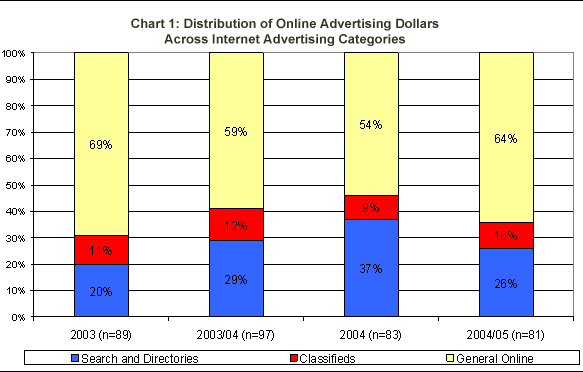China, Central Europe and the Internet Drive Ad Spend
September 7 2005
Carat, part of the Aegis Group, has increased its 2005 forecast of world ad spend growth to 5.2% -highest in China (18%) and Central Europe (11.4%) and lowest in Germany (1%). Its predictions for increased online ad spend are echoed by a new report from Roy Morgan in Australia.
Forecasts for every region are down on levels of growth the previous year, with even Asia Pacific growth steadying slightly, but spend is expected to accelerate again in most countries in 2006.
| |
| | 2004 actual | 2005 forecast
(previous forecast) | 2006 forecast |
| Global | 6.7% | 5.2% (5.0%) | 5.8% |
| USA | 5.8% | 4.5% (4.5%) | 5.0% |
| Asia-Pacific | 7.4% | 6.8% (5.8%) | 7.2% |
| Europe | 5.5% | 4.2% (4.6%) | 4.8% |
| Japan | 5.4% | 2.5% | 3.0% |
| China | 22.0% | 18.0% | 20.0% |
| UK | 6.8% | 3.7% (4.8%) | 4.5% |
| Germany | 1.0% | 1.0% (1.3%) | 2.0% |
| France | 3.5% | 2.0% (2.2%) | 2.3% |
| Italy | 7.9% | 2.7% (3.3%) | 4.7% |
| Spain | 6.0% | 5.1% (5.0%) | 4.6% |
| Nordics | 5.8% | 4.7% | 4.0% |
| CE Europe | 17.5% | 11.4% | 10.9% |
| |
Carat predicts growth of more than 14% in China, Hong Kong, India and Indonesia this year, and believes Asian ad spend will overtake European spending by 2008. After three years of negative growth, the Japanese ad market is recovering, and Carat expects this to continue with the 2005 World Expo boosting the trend.
The European forecast has fallen by 0.4% to reflect slower growth in the UK, Germany, France and Italy, although ad spend remains strong in the Nordic countries and Central and Eastern Europe. Russia is now the 6th largest European market, just after Spain, and the company predicts that Central and Eastern Europe's share of European ad spend will reach 16% in 2006 (vs 12% four years ago). The UK sees the biggest fall in estimated growth - from 4.8% to 3.7%. For 2006, Carat expects that next year's Football World Cup in Germany and the Winter Olympics in Italy will boost spending in Europe.
The US economy is sending contradictory signals, according to Carat. On the one hand, GDP growth and consumer confidence are softer, but the job market and consumer spending remain strong. The 2005 forecast remains unchanged at 4.5% - the same level achieved for the first half of the year, according to a TNS announcement yesterday (see
www.mrweb.com/drno/news4526.htm ).
Commenting on overall trends, Robert Lerwill, Chief Executive of Aegis Group, says 'TV's share of advertising spend is leveling out and newspaper's share is declining, with budgets shifting to the Internet'.
The latest emitch/Roy Morgan
Internet Advertising Intentions and Attitudes Survey, conducted in July, also points to a growth in the importance of online advertising. It finds advertisers, agencies and publishers increasingly optimistic about Internet advertising, though the rise is far from meteoric, and some doubts remain.
This survey is the fourth wave of the series, and is based on telephone interviews conducted with marketing decision makers from 150 prominent Australian advertisers, as well as 28 advertising/media agency decision makers, and senior sales executives from 10 online publishers.
It found that the majority of advertisers (73%, up from 59% in December 2004) agree that 'the Internet will be a vital component of my company's marketing strategy over the next three years'. 54% of advertisers and 71% of agencies have invested in online advertising in the past 12 months - a similar figure to the last survey six months ago. However, prominent advertisers say they will commit an average of only 6% of their advertising spend to online advertising in 2005-2006 (up just slightly from 5% in 2004-2005).

The study shows that the mix of online advertising types is shifting. The proportion of the online budget spent on general Internet advertising (banners and the like) continues to grow. In 2004-2005, advertisers spent 64% of their Internet advertising budget on such ads, up 10% from the 54% reported in December 2004. Meanwhile, advertisers allocated only 26% of their online ad budgets to search and directory advertising - down from 37% in December 2004.
The Internet's targeting capabilities are seen as its greatest advertising strength, mentioned by 23% of advertisers (down from 30% in December 2004). Around one in five (20%, down from 26%) advertisers see customer reach as one of the greatest strengths, and 19% (unchanged) cited the cost effectiveness of the medium. The greatest perceived weaknesses were its limited reach (12%), insufficient audience targeting and tracking (12%) and clutter (12%).
75% of advertisers (up from 73% in December 2004) agreed that
'Advertising on the Internet has high accountability due to the sophisticated measurement tools available' and 74% (up from 66%) agreed that
'The Internet allows me to efficiently reach my target audience'. 72% (up from 59%) agreed that the Internet offers advertisers
'great value for money', and 65% (63%) agreed that
'Advertising on the Internet is an effective way to build brand awareness'.
Carat's web site is at
www.carat.com , and Roy Morgan's at
www.roymorgan.com.
All articles 2006-23 written and edited by Mel Crowther and/or Nick Thomas, 2024- by Nick Thomas, unless otherwise stated.
